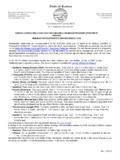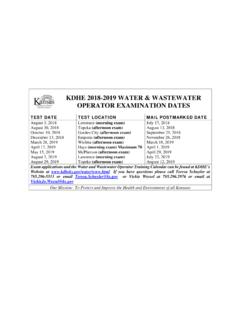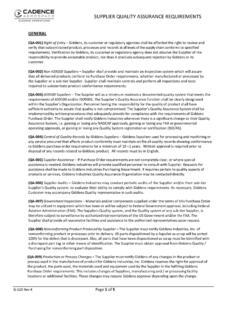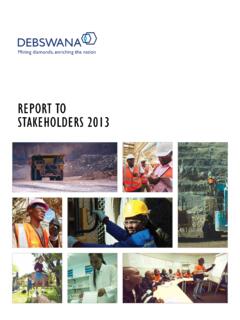Transcription of Calculation of Flashing Losses/VOC Emissions from ...
1 Calculation of Flashing Losses/VOC Emissions from Hydrocarbon Storage Tanks THE Q: What is VOC? A: VOC is an acronym that stands for Volatile Organic Compounds. VOC are components of hydrocarbon liquids such as crude oil and condensate. VOC means any compound of carbon, excluding carbon monoxide, carbon dioxide, carbonic acid, metallic carbides or carbonates, and ammonium carbonate, which participates in atmospheric photochemical reactions. However, there is a list of compounds that are excluded from being VOC because they have negligible photochemical reactivity such as methane, ethane, and fluorinated and chlorinated hydrocarbons.
2 The list of chemicals excluded from the definition of VOC is found in 40 CFR (s) (1). Q: What are Flashing Losses/VOC Emissions from hydrocarbon storage tanks? A: There are three types of Emissions from hydrocarbon storage tanks: working losses , breathing losses , and Flashing losses . Flashing Losses/VOC Emissions occur when a liquid with entrained gases goes from a higher-pressure to a lower-pressure. As the pressure on the liquid drops some of the lighter compounds dissolved in the liquid are released or flashed and some of the compounds that are liquids at the initial pressure/temperature transform from a liquid into a gas/vapor and are also released or flashed from the liquid.
3 As these gases are released, some of the heavier compounds in the liquids may become entrained in these gases and will be emitted with them. Flashing Losses/VOC Emissions are greater as the pressure drop increases and as the amount of lighter hydrocarbons in the liquid increased. The temperature of the 08/28/2006 - 1 - 08/28/2006 - 2 - liquids and the storage tank
4 Will also influence the amount of Flashing Losses/VOC Emissions . These Flashing Losses/VOC Emissions are then either vented to the atmosphere through the tanks pressure relief valve, hatch, or other opening, or they may be vented to a capture and/or control system. Flashing Losses/VOC Emissions from hydrocarbon storage tanks include Emissions of VOC, hazardous air pollutants (HAP), and toxic air contaminants (TAC). Q: Where do Flashing Losses/VOC Emissions from hydrocarbon storage tanks occur? A: The main areas where tank- Flashing Losses/VOC Emissions occur are at: Wellhead sites when produced liquids are sent to an atmospheric storage vessel from the last pressurized vessel; Tank batteries when produced liquids are sent to an atmospheric storage vessel from the last pressurized vessel; Compressors stations when produced liquids are sent to an atmospheric storage vessel from the last pressurized vessel.
5 Gas plants when produced liquids are sent to an atmospheric storage vessels from the last pressurized vessel; and/or When the liquids in the gas lines are pigged (physically purged of condensate) and then sent to an atmospheric storage vessel. Q: What are working and breathing Losses/VOC Emissions from hydrocarbon storage tanks? A: Working and breathing Losses/VOC Emissions from hydrocarbon storage tanks occur in addition to Flashing Losses/VOC Emissions . Working losses are due to displacement of the vapors within the storage tank as a tank is filled.
6 Breathing losses are due to displacement of vapor within the storage tank due to changes in the tank temperature and pressure throughout the day and throughout the year. Working and breathing Losses/VOC Emissions can be estimated with the latest EPA TANKS program or it equivalent. Calculation Q: Do I need to estimate Flashing Losses/VOC Emissions from my hydrocarbon storage tanks? A: Yes, estimates of Flashing Losses/VOC Emissions from hydrocarbon storage tanks will be requested for every facility that has potential Flashing Losses/VOC Emissions from hydrocarbon storage tanks ( , natural gas compressor station s, natural gas processing plants, condensate tank batteries, crude petroleum liquid storage facilities, etc.)
7 However, facilities that are determined to be de minimis or permit exempt facilities are not required to submit Flashing Losses/VOC Emissions for their hydrocarbon storage tanks. The following graph has been included to aid facility operators in determining if Flashing Losses/VOC Emissions from hydrocarbon storage tanks need to be calculated. The graph was developed using the Vasquez-Beggs Equation (VBE) and the default parameters on page 6 of this fact sheet (with the exception of the Stock Tank API gravity).
8 This graph cannot be used if the Stock Tank API gravity of the hydrocarbon liquids in the storage vessel exceeds 60o. Operators may choose to calculate their facility s Flashing Losses/VOC Emissions from hydrocarbon storage tanks using actual site data for a more accurate evaluation. 08/28/2006 - 3 - Q: How do I estimate Flashing Losses/VOC Emissions from my hydrocarbon storage tanks?
9 A: BAR will accept any of several available methods of calculating Flashing Losses/VOC Emissions from hydrocarbon storage tanks so long as the method selected is used only for those site-specific situations consistent with its development and underlying assumptions. There are specific constraints associated with each emission estimation method. All supporting data used to calculate the Emissions , including identification of the Calculation method and specific constraints, description of sampling methods and conditions, and copies of lab sampling analyses must be provided to BAR with the Emissions estimates.
10 The following are some of the methods of calculating Flashing Losses/VOC Emissions from hydrocarbon storage tanks: Vasquez-Beggs Equation (VBE); Environmental Consultants and Research, Inc. (EC/R) Equation; An equation of state (EOS) Calculation program such as E Determination of the gas oil ratio (GOR) and throughput of the hydrocarbon liquids; Process simulators (HYSIM , HYSYS , WINSIM , PROSIM , etc.); and Direct measurement of Emissions VBE The VBE was developed in 1980 as part of a research project at the University of Tulsa.

















